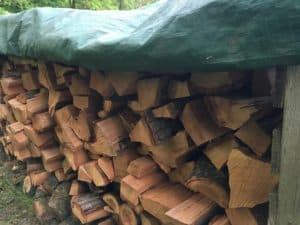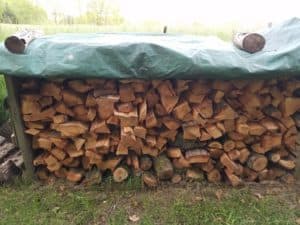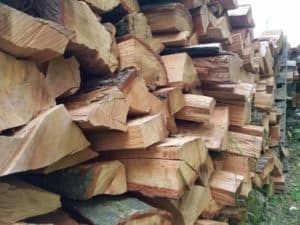Using Wood for heating and cooking is something that has been done for thousands of years and is still used all over the world today. Though it is one of the oldest forms of staying warm and preparing meals there is surprisingly a lot to know on the topic of wood as fuel. One of the most common questions I hear is “if I want to burn wood, how long can I store the wood without it going bad?” the answer really depends on how and where you have stored the wood. If you do it the right way wood can store for 3 to 5 years outside and even longer indoors. However, you need to make sure that you know what you are doing and are aware of some of the risks of burning wood as well. So what are the right ways to store wood to make it last the longest?
Keep your wood off the ground
Nothing will cause your wood to rot faster than leaving it on the ground. The moisture from the ground will absorb into your wood like a sponge and start to break down the fibers. Also, bugs will burrow into your wood and lay eggs and chew holes into the wood. If moisture is trapped inside these channels it will begin to rot from the inside out. Finally, the fungus will grow on the moist wood deteriorating and jeopardizing the wood.
Wind flow is good
Stacking the wood in a way that allows the pass-through of air is a must. Wind flow helps dry out your new wood much faster as well as discourages bugs and rodents from making piles of wood their home. Here are a few examples of how you can stack wood for good airflow.

Keep the rain off your wood
I make sure that I can limit the amount of rain my wood sees by using a tarping method for my wood stacks. This method stills allows for the pass-through of air but helps cut down a good portion of the rain that makes contact with the wood. Here is what I do.

How long should you wait before you burn your wood?
As a general rule, you should allow your green wood (live wood that was cut down) to age one “season” or for one year. That should be enough time for the moisture content to drop to a safe level. If you burn green wood indoors you increase the risk of creosote build up in your chimney. Also, when the moisture level is too high in your wood you will not be able to heat as efficiently as you should. The moisture will rob your wood from burning long and hot.
The best way to maintain well-seasoned wood is to keep your wood on a rotation. You should keep track of the amount of wood you burn for a given heating season and in the next year store up that amount in green wood. You may need to buy your wood for the first year as you allow your first store of wood to age or you can find standing dead trees and use those. After you have one heating seasons worth of wood put up and you will be butting up wood during the summer for not the coming but the following winter.
If you put the word out that you are always on the lookout for wood it is pretty easy to get what you need from year to year for free. Offer to help clear trees for friends or help remove large branches that fall in storms. You can ask people who remove trees for a living if you could help remove wood for them for just the wood as payment. You could even talk with landowners and see if they would let you take the standing dead trees that are on their property.
How do you know when the wood is dry enough to burn?
Look
You can learn a lot about the condition of your wood if you know what signs to look for. Some of the visual signs of dry wood are things like color. If the wood has faded in color to a dull tan this is a sign of low moisture. Also, look for cracks in the wood and separation of the bark. As the wood dries the bark will begin to peel off easily from the wood itself. These are all great signs that your wood is ready to burn.
Sound
Another clue to the condition of your wood is the way it sounds. If you take two pieces of your wood and hit them together you will hear one of two sounds. Either a nice, loud, hollow, almost musical crack. Or, a soft dull thud. The thud is a sign of high moisture and means the wood is not ready. The hollow crack means the wood is nice and dry.
Smell
The smell of fresh cut “Green” is unmistakable. As time passes the scent of the wood will be less strong. As the smell grows fainter the wood is evaporating more of its moisture. When the wood is ready to burn it will have only a very faint smell of its original scent. You should have to almost place your nose on the wood to smell anything at all.
Age
Most wood will be completely seasoned after two years from the time it was cut down. As long as you have followed the previous requirements for storing, your wood should be ready to burn. Remember, if you place your wood on a two-season rotation and make sure that your wood is off the ground, has good airflow, and stays dry you should have nice seasoned firewood every year.
What are the dangers of burning green wood?
Burning green wood or wood that had not had time to dry out properly can increase the danger of a house fire. When wood burns it sends gasses, smoke, carbon, and creosote into the chimney. The wetter the wood the more of these things the wood excretes. These particles can build up in your chimney over time and eventually if not cleaned out can catch on fire.
If you burn any kind of wood for heat it is important to have your chimney cleaned at least one time per year. You can hire out the work or if you not afraid of climbing onto your roof you can buy the brushes yourself. The brushes you use should be a little bit bigger than the diameter of your chimneys exhaust tube.
What is the best wood to burn?
All wood will burn but for efficiency’s sake, you should stick to the woods that burn longer and hotter. These are the denser hardwoods. A few examples of these would be Fruit trees like Cherry and Apple trees, as well as Ash (a really nice splitting wood) Hickory, Oak and Walnut
Now, there are advantages to having a mixture of woods in your stores. The pine woods have a high resin content and will light easy. Using these to get your fires started is a great option. Also getting your hands on some of these softer woods is much easier. A few of my favorites are Red pine, spruce and fir trees
A few other things to be aware of:
Bugs
All kinds of bugs live in wood. Many of these bugs lay their eggs in the wood and when you bring it into your home and warm up the wood, the eggs may hatch. It is a good idea to keep the wood you burn outside for as long as possible if you would like to minimize this potential problem.
Ash and dust (sensitive lungs)
During the winter months, we tend to keep our homes shut up nice and tight to keep all the heat in. Unfortunately, that doesn’t allow the ash and dust we create by burning wood to escape easily. This can cause respiratory irritation to some people. It is a good idea to ventilate when you can and use an air purifier if possible.


